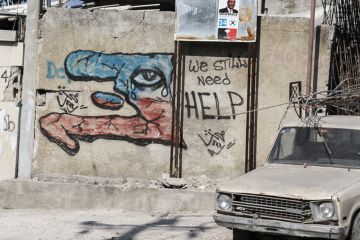Over the past few decades, Iran has transformed from being the greenest nation in the Middle East to a country grappling with worsening air pollution and rising temperatures. Today, the capital city of Tehran is among the most polluted cities in the world. The rise in air pollution, which in part consists of uranium particles released by Iran’s nuclear plants, have bred increased incidences of respiratory diseases and cancers; frequent oil spills have also significantly harmed the vibrant aquatic life of local water bodies including the once pristine Caspian Sea and Persian Gulf. It is clear that a whole host of environmental problems that require the input of climate change experts have burgeoned under the Islamic Regime, and yet, environmentalists are continually imprisoned under falsified charges. The Iranian regime’s actions against climate resiliency as well as its failure to effectively handle the country’s climate crisis have crumbled Iran’s conservationist movement and exacerbated the effects of climate change in the nation.
The Imprisoned Environmentalists of the Persian Wildlife Heritage Foundation
After nearly a year in detainment, a slew of conservationists who worked for the Persian Wildlife Heritage Foundation (PWHF), a not-for-profit that studies and protects the endangered Asiatic Cheetah, were issued prison sentences of up to ten years in November 2019 for corroborating with the U.S. government in a capacity that has been left unspecified by the Revolutionary Court. The verdict was taken during a nationwide Internet shutdown, which many believe was timed to avoid public scrutiny for the court’s assignment of drawn-out prison sentences. Nonetheless, there has been international outcry in response to the jailings: in a letter addressed to Iran’s Supreme Leader, Ali Khameini, more than 330 environmentalists from across the globe called for the release of the imprisoned PWHF conservationists; 26 members of the European Parliament also wrote to President Rouhani expressing their concerns over the jailing. Indeed, Kavous Seyed Emami — an Iranian-Canadian sociologist and conservationist and one of the PWHF prisoners — has died while in detention under notably dubious circumstances. So, why are they still in prison, and what was the motive behind having them imprisoned in the first place?
Iran’s Environmental Crisis
In Iran, environmentalism is heavily politicized because, in some way or another, most activists and conservationists are perceived by the authorities as posing a threat to the regime. Though the Iranian government has traditionally weathered most of its domestic dissident movements through lethal force and intimidation, their political illegitimacy, or the widespread dissent among Iranians towards the regime (which is masked by the country’s lack of free and fair elections), still makes their reign fragile. In reporting on the country’s unique natural heritage and resources, environmentalists and conservationists end up spotlighting the ways in which the regime’s environmental missteps are negatively affecting the environment and, by extension, the lives of Iranians. There are numerous examples of the Islamic Republic’s many careless environmental missteps. For example, the burning of forests located in Northern Iran, where humidity is high and wildfires do not occur, is believed by many to be a result of deforestation orchestrated by the government. The regime has also left the oil pollution and dumped waste in the Persian Gulf unchecked, jeopardizing the livelihoods of Iranian fishers who depend on the water body for produce. The regime has also failed to halt the shrinkage of Iran’s Lake Urmia, once the second largest saltwater lake in the world. The lake’s desiccation has exposed its salt contents, increasing the frequency of salt storms and hurting local farmers and breeding health issues in surrounding residents. Many Iranians closely identify with the country’s natural assets: the local Azeris and Kurds, two ethnic populations in Iran, have voiced major concerns about the disappearing Lake, labeling the water body as a symbol of their cultural identity.
Environmentalism: What’s on the Line for the Regime
What makes drawing attention to these actions (via published papers, interviews, and research projects, for instance) problematic for the regime is the fact that a movement for the environment would likely unite a diverse band of Iranians. The effects of the government’s environmental mismanagement affect everyone; from pollution-related health issues, to robbing them of cultural keystones, to hindering Iranians’ lifestyles and livelihoods, the anger invoked by the desiccation of these environmental features holds the potential of galvanizing protests. All in all, the wide-ranging consequences of the regime’s environmental destruction could unite a broad, diverse group of citizens to mobilize against the regime.
The Weight of Iran’s Environmental Issues
The conservationists working for PWHF remain behind bars, as do many other important environmental figures. While it is still unclear why their work protecting and studying Iran’s endangered Asiatic cheetah was grounds for unjustified imprisonment, something else is clear: The Islamic Republic has sent the message that citizens should stay out of government undertakings or risk punishment. However, the unavoidable fact remains that Iran’s strategic position in the Middle East makes its environmental crisis a destabilizing threat to the globe. For this reason, international governments must make environmental cooperation with Iran a top priority. Their intervention should include demanding the release of the unacceptable number of Iranian environmentalists imprisoned on the basis of unproven charges, including PWHF researchers. After all, Iran’s current regime has already proven its inability to effectively respond to the climate crisis; without its environmental experts, the nation’s natural resources will continue to be at risk.
Featured image of Lake Urmia by NASA’s Marshall Space Flight Center. Licensed under CC BY-NC 2.0.




